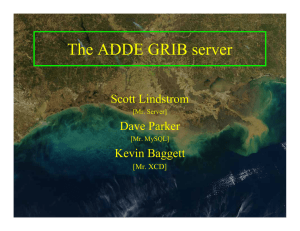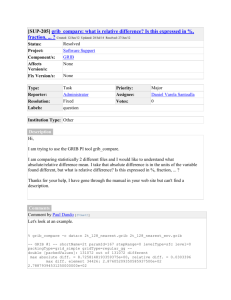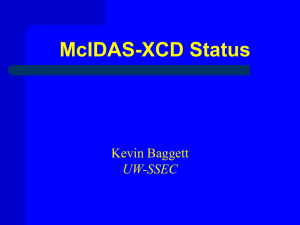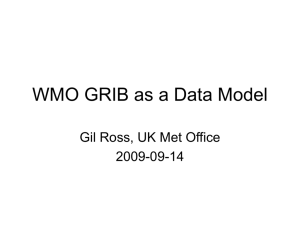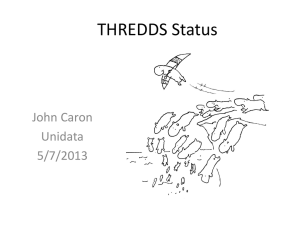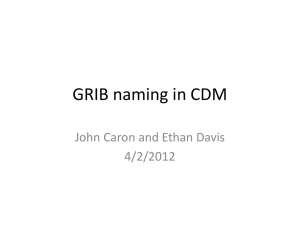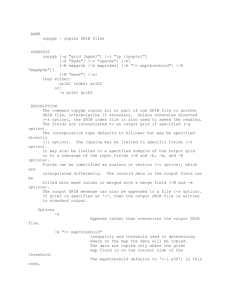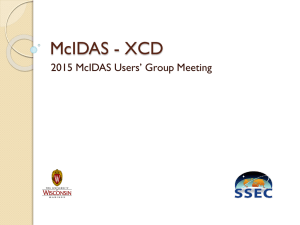The ADDE GRIB server Scott Lindstrom Dave Parker Kevin Baggett
advertisement
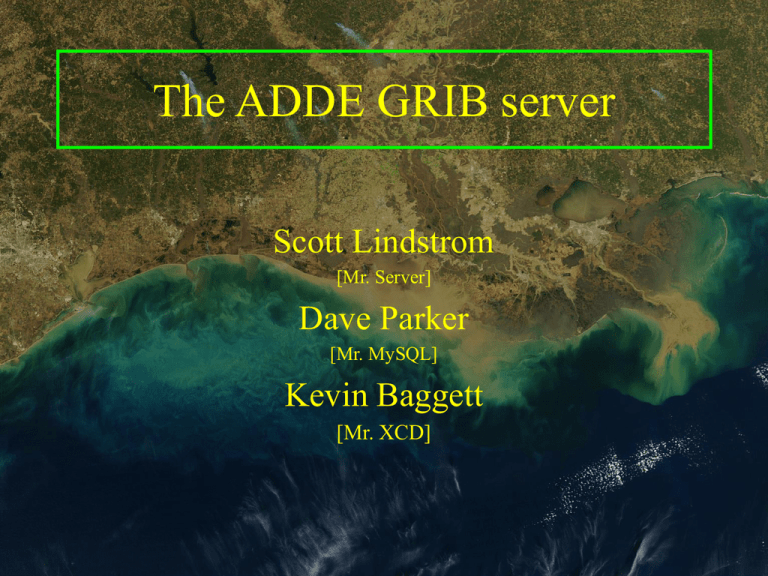
The ADDE GRIB server Scott Lindstrom [Mr. Server] Dave Parker [Mr. MySQL] Kevin Baggett [Mr. XCD] The ADDE GRIB Server • Run in real time with XCD decode • Run with archived data • Run with and without a database to speed execution ADDE GRIB Server Requirements • Requires up-to-date gbtbpds files – Converts numbers in GRIB files to • Generating Stations (NCEP, ECMWF, ….) • Level • Parameter – 4-character limitations • etc. ADDE GRIB Server Requirements • Problems: – GRIB files can number in the 1000s • Significantly slows searching times – Tables can become out of date • Values can also be defined within the GRIB file GRIB Server with Database • Run in real time with XCD • Run with archived data WHY? • GRDLIST RTGRIDS/ALL DAY=#Y TIME=0 FHOUR=108 SRC=GFS LEVEL=1000 PAR=U GRIB=2526 33 94 100 FORM=ALL took 3.5 minutes • GRDLIST RTGRIBS/ALL DAY=#Y TIME=0 FHOUR=108 SRC=GFS LEVEL=1000 PAR=U GRIB=2526 33 94 100 FORM=ALL took 2 seconds Step 0 • Have system administrator install MySQL and configure the root mysql user password • Verify install using test scripts that come with MySQL The ‘gribadmin’ Script • /home/oper/bin/gribadmin – Creates/removes the grib database • ./gribadmin makedb – [enter the mysql root password] to create database • ./gribadmin fields – [prints out the field names from the “grib” database] • ./gribadmin removedb – [enter the mysql root password] to delete database What Does the Database Hold? • Everything that is filed in the McIDAS grid header • GRIB file name, and byte offset to grid data - [used to speed access] • Extended parameter/projection names • GRIB version (1 vs. 2) What Does the Database Hold? • XCD must initially partially decode grid, but the directory server then just retrieves all the data from the database • Get server still has to decode entire grid, but the stored GRIB file and offset speed the decoding What Does the Database Hold? | grib_type | gen_proc_ID | j_day | runtime | forecast_day | forecast_hour | forecast_time | geo_ID | level_ID | param_ID | ptr_to_grid | param_short | param_long | param_scale | param_units | level | level_scale | level_units | model_name | proj_short | proj_long | grib_file_name | grib_version | grid_size | num_rows | num_columns | num_points | nav1 | nav2 | nav3 | nav4 | nav5 | nav6 | type_mask | time_ave_diff | lev_ave_diff | period_1 | period_2 | modtime | Are There Any Issues? Because the number of bytes to be transmitted must be known, must know number of grids going; must know number of stitched grids, too Each packet of stored information: ~3500 bytes If you are listing ALL -- >100000 grids -- you can bump up against a resource limit if your server machine is heavily used Are There Any Issues? Comparisons with RTGRIDS datasets have been very favorable Access via RTGRIBS is usually faster Real-time testing to begin in SSEC Data Center by end of December Things to Consider with Archived Data • Fully resolved pathname determined using Mcpathname -- make sure the path is in MCPATH (and watch the REDIRECTs) • LD_LIBRARY_PATH must include link to mysql libraries in mcadde (.profile or .mcenv) – LD_LIBRARY_PATH=/usr/local/mysql/lib/mysql:$LD_LIBRARY_PATH Things to Consider with Archived Data • You can build a database to access archived data as well • Running two databases on one machine has not yet been tested
